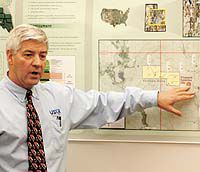| USTAR official Al Walker details the process of CO2 sequestration for the governors’ office of economic development and local officials. |
The Governors’ Office of Economic Development board (GOED) met in Price Friday to review issues centering around a large scale carbon dioxide sequestration project and allowing Castle Valley economic development personnel to present their current projects and goals to the state body.
The sequestration presentation was given by Al Walker of the Utah Science and Technical and Research Institute. According to Walker, the sequestration project will be a Southwest Regional Partnership and the new phase of a $67 million project planned by the U.S. Department of Energy is scheduled to take place within the Farnham Dome just east of Wellington.
Sequestration is the process of taking carbon dioxide and pumping it into deep rock formations for long term storage.
Walker reported that the area is ideal for the carbon dioxide sequestration due to the fact that there is a pre-existing, 100 million year old deposit already in the area. Also the layered geology is perfect for trapping the carbon dioxide.
Many local officials including the governor feel that if carbon sequestration succeeds it would go a long way to curbing the harmful nature of Carbon dioxide gas, a major global warming contributor. While the project will not employ a large number of residents, it will give new life to some Carbon industry by offsetting the Carbon dioxide pollution put out by Castle Valley power plants and enhance production in many local oil fields.
According to Walker, this project will set the standard for all projects to come.
Following Walker’s presentation Castle Valley Economic Development directors Delynn Fielding and Mike McCandless gave short presentations to the GOED board.
“You dance with the girl that brought you to the dance but you wink at all the rest,” said McCandless, Emery County Economic Development Director. “What I mean is coal is the girl that has brought our counties along, but we really need to look to diversify and I think the diversification is coming along.”
According to McCandless, officials in both counties are sick of seeing the areas brightest youth be exported to other areas to work.
“We are looking at a serious crisis here with baby boomer retirement especially in our power plants,” said McCandless. “How are we going to fill these jobs? We need to find a way to keep our kids at home working these good high paying jobs.”
| Emery County ED directory Mike McCandless addresses the board. |
McCandless reported that Emery County has a 3000 acre industrial park in the works near the town of Green River, which has full rail service as well as the water resources made available by the adjacent river.
For his part Fielding, Carbon County’s director reminded all in attendance just how skilled a coal miner is.
“These men have amazing skill sets,” said Fielding. “They weld, have electrical experience, operate advanced state-of-the-art equipment and know how to take it down and repair it. These skills make coal mine employees prime for any type of manufacturing venture.”
According to Fielding, the Utah coal industry employed 8,000 workers in the 1980’s. However, the same mines employ 2000 residents today and are producing more coal.
“The technology changed,” said Fielding. “Things become more automated every day.”
The economic team reported that the SoutheasternUtah Wilderness Alliance had settled their case with Murray Energy and the permitting from Lila Canyon had come through.
“That could mean 260 new jobs for the local economy,” said McCandless. “That is going to be a big shot in the arm.
Fielding’s final presentation reported on the continuing Business Expansion and Retention Project.
According to Fielding more than 800 businesses have been interviewed so far and some really meaningful data is now coming to light.
“The best thing we can do for the local economy right now is to grow and retain the businesses we have,” concluded Fielding. “That infrastructure of small local business is what is going to keep us going during the bust portion of the recurring boom/bust cycle.

